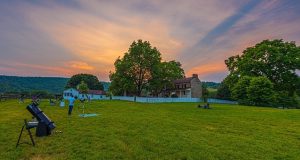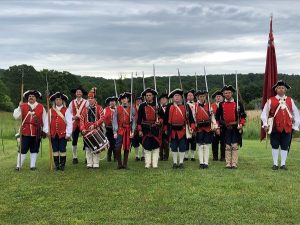Interesting Things to Know
How the Irish saved the War of American Independence
Did you know that during the War, St. Patrick’s Day was celebrated on the orders of General George Washington? Washington also forbade the celebration of Guy Fawkes’ Day among his troops. At the time in England, that was celebrated throughout the country with anti-Catholic demonstrations – but it never became an American custom, thanks to Washington’s sympathy with his Irish troops.
The American War of Independence could not have been won if it were not for the Irish. It is certain that Irish soldiers constituted two-fifths of the Continental Army by the time Washington reached Valley Forge in 1778. That proportion grew as time went on.
Washington’s step-grandson, George Washington Parke Custis, wrote: “Ireland furnished one hundred men to any single man furnished by any other foreign nation.”
At that time, “Irish” meant anybody who sailed from a port in Ireland. According to historians, overall total Irish immigration might have been as high as 500,000 – or roughly one-quarter of the estimated two million population in America at the time of the American War of Independence.
Irish immigration to America reached its peak during the first half of the decade of the 1770s. By 1776, one-quarter of the entire population of North America was Scots or Scots-Irish.
Actually, probably 300,000 of those “Irish” were what today would be called “Scots-Irish,” namely descendants of mostly Presbyterian settlers from Scotland living in Ireland’s northern province of Ulster. Catholics from Ireland had come over earlier because, by 1770 in Ireland, only 5% of the land was owned by Catholics – who were 90% of the population.
The imported Scots had a difficult time in Ireland. First, they were caught in the middle of the Irish wars against England and then the English Civil War. It’s estimated that 100,000 Scots settlers died in the English Civil War – along with more than 500,000 Irish Catholics.
But it didn’t get better. In 1703, Queen Anne signed the Test Act. This decreed that Presbyterian ministers could not legally marry, baptize, or bury anybody. Presbyterians who did not marry in Anglican churches were legally considered fornicators and their children bastards! Presbyterians were not allowed to teach school or serve as officers in the militia – religious restrictions similar to those against Catholics.
In 1718, the first ships of Scots-Irish arrived in Boston to a chilly welcome. One group was led by the Rev. James McGregor, who delivered a farewell sermon before departure. They were fleeing Ireland, he said, “to avoid oppression and to have an opportunity of worshipping God according to the dictates of conscience and the rules of His Inspired Word.” But Boston didn’t want them. Only two years later, Boston passed an ordinance ordering “families arriving from Ireland” to move on. And move on, they did.
Scots and Irish, like the Welsh and Cornish, are Celts – not Anglo-Saxons, like the English. They were not tame city dwellers; they were (and still are!) known as intensely loyal to their clan and more obedient to their chief than to any written law. They are fierce fighters who would die rather than surrender. They became the quintessential American frontiersmen.
William Penn was a Quaker, a man of peace. He didn’t want the fractious fighting Irish in his City of Brotherly Love – but he knew they might be useful elsewhere. There were Indians west of Philadelphia, and Penn thought the Irish would be a good buffer between him and the Indians – so he allowed them to settle west of Philadelphia.
If you drive along the I-81 in Pennsylvania, you will see exits named Letterkenny and Antrim – both towns in Ulster, relics of those first settlements. And if you head south, where do you get? The Shenandoah Valley.
The Western frontier of Virginia, Maryland, and Pennsylvania contained the largest Irish populations.
This did not bode well for England — because the Irish and Scots, Catholic and Presbyterian, arrived on these shores with a deep hatred of England and the crown. They didn’t need to be persuaded by Tom Paine and Patrick Henry that the King didn’t have their best interest at heart – they knew it firsthand!
Those stirring tracts were written to convince the original settlers, who considered themselves loyal sons of England, not to trust the King or Parliament. Remember: most of the first English settlers in America thought of themselves as loyal subjects of a benevolent king who ruled by the Divine Right of Kings; those English settlers had to be convinced to break away from England.
The Scots-Irish Presbyterians were ferocious advocates of Independence: King George III, based on information he received from his military reports, denounced the conflict in America as that “Damned Presbyterian War.” He referred to “Those pestiferous Presbyterians [who] are always in unrest and will be until they are wiped out.” Presbyterian ministers were known as the “Black Regiment” because of the black robes they wore when they preached – not only the word of God but also rebellion against the King.
The War of Independence got off to a rocky start. When the first enlistments were up, those New England boys, aka summer soldiers and sunshine patriots, headed back to the farm. The Continental Congress was not very happy with the Scots-Irish army: as English gentlemen, they had inherited contempt for the Scots and the Irish and didn’t think they would be able to fight. So they took their time to send funds.
Early on in the war, George Washington knew he was in trouble – and good leader that he was, he made plans for what if the worst came to the worst.
In November 1776, after the loss of New York and Long Island, he confided to his aide-de-camp Col. Joseph Reed that he might have to withdraw his reeling army first to the Shenandoah Valley, then farther west beyond the Allegheny Mountains to keep the ‘flames of revolution’ alive. He knew the Scots-Irish western frontier would provide “an asylum” for his rebel army.
Washington never needed to escape to our Valley, but it’s good to know that he thought so highly of our loyalty!
But the Irish re-enlisted, and more enlisted. When General Charles Lee was captured in 1778, he told the British that Washington’s army was half-Irish. Joseph Galloway, a member of the Continental Congress who defected to the British, later reported to the House of Commons that the Continental Army was ¼ native-born Americans, ½ Irish, and ¼ English and Scots.
In any case, the Irish were there in time to fight in the war’s major turning points: Trenton in December 1776, Princeton in January 1777, Saratoga in October 1777, Kings Mountain in October 1780, and Cowpens in January 1781.
When the British took Savannah, Georgia, and Charleston, SC, 5,500 Continental soldiers surrendered in Charleston on May 12, 1780. English general Henry Clinton announced that “the most violent Rebels are candid enough to allow the game is up” and sailed back to New York to rest on his supposed laurels, leaving his second-in-command Lord Cornwallis in charge.
What Clinton didn’t know was that the Americans had only begun to fight. The great majority of the population of the Carolinas was in the mountains – and they were Scots-Irish, whose fighting skills had only improved with a generation or two of dealing with Indians.
The British thought they would advance on three fronts: the coast, the center, and the mountains. British Major Patrick Ferguson sent a captured prisoner back home across the Blue Ridge Mountains with the message to “desist from their opposition to British arms, or he would “march his army over the mountains, hang their leaders, and lay waste their country with fire and sword.”
Guess again, Major! Those were fighting words to the Celts – and rather than being intimidated, their resolve grew stronger. In the words of one British officer, the Scots-Irish mountain men were “more savage than the Indians.” The Kings Mountain battle in North Carolina defeated the British – Americans annihilated 1,100 Redcoats with only 28 killed and 62 wounded Americans.
That success solidified resistance to the British throughout the South. Six months later, in January 1781, came the Battle of Cowpens in South Carolina. The British saw nine-tenths of their force killed or captured there, while the Americans had 12 killed and 60 wounded. In Col. William Thompson’s South Carolina Rangers, the Irish immigrants outnumbered the South Carolina-born men.
On October 19, 1781, Lord Cornwallis surrendered at Yorktown.
Washington could not have won the war without his foot soldiers. At least two-thirds and possibly three-fifths or more of them were Irish. So indeed, the Irish saved the American War of Independence.
In the words of George Washington Parke Custis: “Who felt the privations of the camp, the fate of the battle, or the horrors of the prison ship more keenly than the Irish? Washington loved them, for they were the companions of his toils, his perils, his glories, in the deliverance of his country.”
So this year, on Saint Patrick’s Day, celebrate not only Ireland – but also Ireland’s first gift to America: victory in the War of Independence.
Interesting Things to Know
The Mystical Origins of “Abracadabra”: A Journey Through Time and Magic
Interesting Things to Know
The 1975 “No S” Roosevelt Dime: A Hidden Treasure Worth Half a Million Dollars
Interesting Things to Know
The Return of Communal Tables: A Revival of Tradition in Modern Dining
The dining scene embraces an old tradition with a modern twist as communal tables make a comeback in restaurants nationwide. From the bustling streets of New York, Chicago, and Boston to smaller cities, these large tables that seat multiple parties are becoming increasingly popular.
Historically, communal tables were the norm in European inns and dining halls until the 19th century, when private tables began to emerge, first in Paris. Despite this shift in the West, communal seating continued to thrive in places like Japan and other parts of Asia. Today, as society grapples with the digital age’s isolating effects, these tables are reappearing in restaurants as spaces that foster social interaction and community building.
Sitting anywhere from 8 to 16 diners, communal tables are a nod to bygone eras and a smart business strategy for restaurateurs. They maximize seating capacity and provide a flexible option for accommodating larger groups, which might require complex arrangements of smaller tables.
For guests, the experience of dining at a communal table can be a leap out of their comfort zones. Yet, many find it a refreshing opportunity to engage with new people, turning what could be a simple meal into a memorable social event. The concept encourages diners to connect in an increasingly rare way in our screen-dominated lives, offering a chance to meet friends you never knew you had.
Whether you’re dining alone, with friends, or looking to make new ones, communal tables offer a unique culinary and social experience that combines the charm of historical dining practices with the dynamic needs of modern life. So next time you’re out, consider choosing the communal table—it might transform your dining experience.
Interesting Things to Know
Celebrity May Birthdays!
Do you share a birthday with a celebrity?

Roma Downey, 60, actress (Touched by an Angel), Derry, Northern Ireland, 1964. Photo by Salvation Army USA West – JG1_7228, CC BY 2.0, https://commons.wikimedia.org/w/index.php?curid=47458719
1 – Judy Collins, 85, singer, Seattle, WA, 1939.
2 – Jenna Von Oy, 47, actress (Blossom), Newtown, CT, 1977.
3 – Engelbert Humperdinck, 88, singer, born Gerry Dorsey, Madras, India, 1936.
4 – David Guterson, 68, author (Snow Falling on Cedars), Seattle, WA, 1956.
5 – Henry Cavill, 41, actor (The Tudors), Jersey, Channel Islands, U.K., 1983.
6 – Roma Downey, 60, actress (Touched by an Angel), Derry, Northern Ireland, 1964.
7 – Peter Carey, 81, author (Oscar and Lucinda), born Bacchus Marsh, Australia, 1943.
8 – Stephen Amell, 43, actor (Arrow), Toronto, ON, Canada, 1981.
9 – Billy Joel, 75, singer, composer, born Hicksville, NY, 1949.
10 – Jason Brooks, 58, actor (Days of Our Lives), Colorado Springs, CO, 1966.
11 – Matt Leinart, 41, sports analyst, former football player, 2004 Heisman Trophy winner, Santa Ana, CA, 1983.
12 – Bruce Boxleitner, 73, actor (Babylon 5), Elgin, IL, 1951.
13 – Julianne Phillips, 62, actress (Allie & Me), Lake Oswego, OR, 1962.
14 – Mark Zuckerberg, 40, founder of Facebook, White Plains, NY, 1984.
15 – Chazz Palminteri, 73, actor (A Bronx Tale), playwright, the Bronx, NY, 1952.
16 – Pierce Brosnan, 71, actor (Remington Steele), County Meath, Ireland, 1953.
17 – Sendhil Ramamurthy, 50, actor (Heroes), Chicago, IL, 1974.
18 – James Stephens, 73, actor (The Paper Chase), Mount Kisco, NY, 1951.
19 – Lainey Wilson, 32, singer, Basken, LA., 1992,
20 – Timothy Olyphant, 56, actor (Justified), Honolulu, HI, 1968.
21 – Sarah Ramos, 33, actress (Parenthood), Los Angeles, CA, 1991.
22 – Naomi Campbell, 54, model, actress (Empire), London, U.K., 1970.
23 – Jewel, 47, singer (Pieces of You), born Jewel Kilcher, Payson, UT, 1974.
24 – Bob Dylan, 83, Rock and Roll and Songwriters halls of fame composer, singer, born Robert Zimmerman, Duluth, MN, 1941.
25 – Cillian Murphy, 48, actor (Oppenheimer), Douglas, Ireland, 1976.
26 – Lenny Kravitz, 60, actor (The Hunger Games), singer, musician, songwriter, New York, NY, 1964.
27 – Richard Schiff, 69, actor (The West Wing), Bethesda, MD, 1955.
28 – Gladys Knight, 80, singer, Atlanta, GA, 1944.
29 – Carmelo Anthony, 40, basketball player, New York, NY, 1984.
30 – CeeLo Green, 49, singer, rapper, record producer, born Thomas DeCarlo Callaway, Atlanta, GA, 1975.
31 – Chris Elliott, 64, writer, comedian, New York, NY, 1960.
Interesting Things to Know
Crafting a Joyful Retirement Beyond the Finances
The financial aspect often takes center stage when the conversation turns to retirement. However, a critical component of retirement planning goes beyond the numbers: social connectivity. As careers wind down and the daily interactions of the workplace fade, maintaining relationships becomes a task that requires intention and effort. The importance of this aspect can’t be overstated, as highlighted by an extensive 85-year study by Harvard, which revealed that social fitness is paramount to achieving a happy retirement.
The study’s findings underscore that while retirees may not miss their former jobs, they deeply miss the social connections formed in the workplace. This suggests that a fulfilling retirement involves much more than pursuing hobbies or leisure activities; it hinges on the richness of our personal connections.
Psychologists Robert Waldinger, PhD, and Marc Schulz, PhD, emphasize the importance of nurturing these connections even before stepping into retirement. They encourage reflecting on the relationships that bring joy and fulfillment and taking steps to strengthen those bonds. Appreciating and valuing the people in our lives today lays the groundwork for a socially rich retirement tomorrow.
For those already in retirement and feeling a gap in their social lives, Waldinger and Schulz offer guiding questions to help identify what connections are missing and how to foster them. Whether reaching out to someone you’d like to know better, seeking out individuals with different perspectives, or even embarking on activities you never considered before retirement, the goal is to create a diverse and enriching social landscape.
Stanley Bing, a Forbes humorist, humorously suggested establishing a “daily grind” in retirement to appreciate the joy of vacations and advised maintaining a healthy distance from becoming too entangled in family members’ daily lives. His take, while humorous, underscores the idea that retirement should be a time of personal growth and exploration.
A happy retirement is multifaceted, encompassing financial stability, personal fulfillment, and, importantly, active engagement in a social network. Cultivating and maintaining these connections enriches our lives and ensures our retirement years are vibrant and joyful.
Interesting Things to Know
The Heist of the Century: How an Aging Mobster’s Quest for Judy Garland’s Ruby Slippers Went Awry
In a tale that seems pulled straight from a Hollywood script, Terry Jon Martin’s life took a turn towards the criminal when he set his sights on one of the most iconic pieces of film memorabilia: the ruby slippers worn by Judy Garland in The Wizard of Oz. Unbeknownst to Martin, who grew up far removed from the movie’s cultural impact, the slippers’ true value lay not in precious stones but in their irreplaceable cinematic history.
After a tumultuous life of crime and multiple prison sentences, the last of which ended in 1996, Martin sought a fresh start in Grand Rapids, Minnesota. This quiet town, coincidentally the birthplace of Judy Garland, hosts a museum dedicated to the actress, within which a pair of the famed ruby slippers were displayed. In 2005, driven by misinformation and the lure of what he believed to be a final, lucrative heist, Martin embarked on a daring smash-and-grab to claim the slippers, insured for a rumored million dollars.
However, the dream of a final big score quickly dissolved. Within days of the successful theft, Martin discovered the disappointing truth—the slippers’ “gems” were mere fakes, rendering the shoes nearly worthless on the black market. Discarding the slippers, he returned to his ordinary life, leaving the shoes hidden from the world.
The slippers’ disappearance remained a mystery until 2018 when they were recovered in an FBI sting operation. This closed a chapter on one of the most intriguing heists in film memorabilia history. Martin, now 76 and facing the end of his life in hospice care, confessed to his role in the theft in federal court last year. Due to his health and condition, he was spared prison and sentenced instead to supervised release for his remaining days.
It remains unclear whether Martin has ever watched the film that once inspired his criminal aspirations. What is certain, however, is that the legend of the ruby slippers—and the man who dared to steal them—will continue to captivate audiences, much like the movie that started it all.









































































